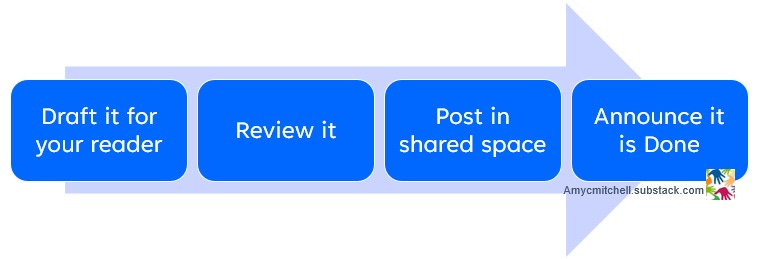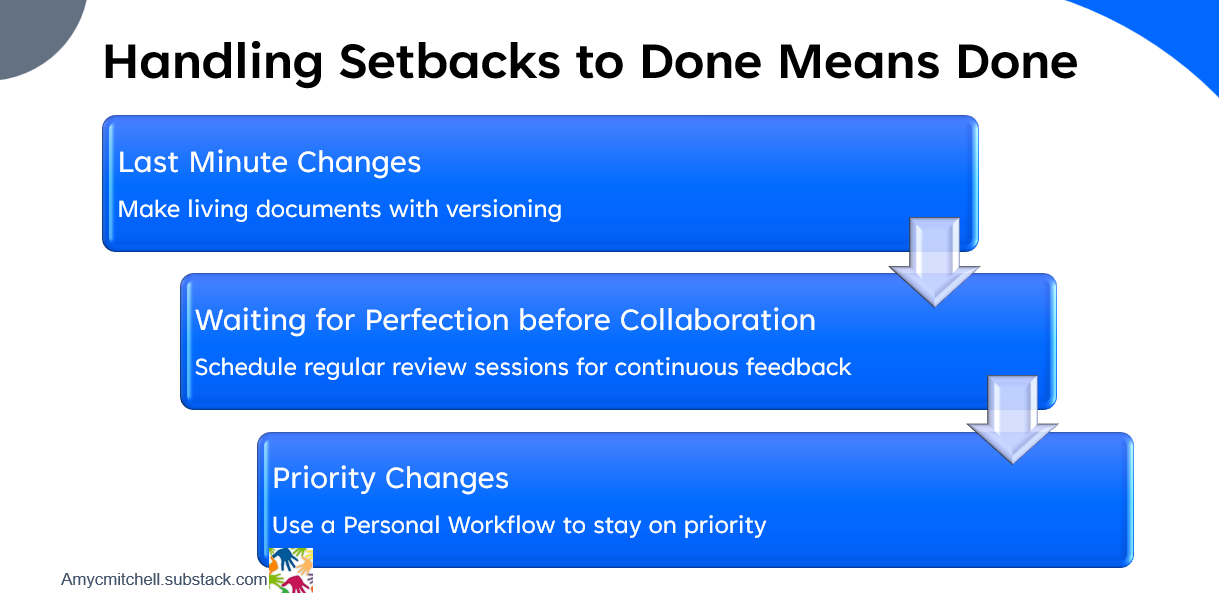How to Prevent Being Buried by Work as a Product Manager
Three Steps to Gain Control of Your Work In Progress
This article is part of Maarten’s summer guest writer series. During my summer break from writing, I want to shine a spotlight on great content written by others.
Five minutes before our meeting, the product manager sent a request to reschedule. This wasn't the first time—our last meeting was also postponed due to an urgent VP request.
I caught a glimpse into his world when he shared his screen. I noticed 1000 unread emails and 10 unread instant message chats.
Feelings of sympathy and anger hit me at the same time. Sympathy that I’m yet one more conflict hitting his busy world. Anger that I’m dependent on a product manager who doesn’t have time to collaborate.
I'm not sure if he realizes how his perpetual overload impacts others. He seems unable to manage his workload effectively. What is causing this product manager to juggle so many activities that he has no time left for collaboration? Like his overflowing email and instant messages, he has too much unfinished work.
Too Much Unfinished Work is Causing Overload
The busy product manager is holding up my work because:
I need his forecast to complete my business case
He met with a customer and has information for my PRD
He worked with the product architect and knows the best way to work with the engineering team
I sympathize with the busy product manager because I’ve been too busy to help fellow product managers in the past. I got so wrapped up in my initiatives that when I needed support from others, there was no one I could call.
I needed to free up time for collaboration. To get control of my in-progress work, I took these three steps:
Be clear on my Definition of Done
Get to know who is waiting for my work
Build habits to keep work flowing
I was pleasantly surprised that these three steps focused my effort on priority work at the right time. Let’s dig into these three steps more.
Your Definition of Done Matters
A key part of your brand is your Definition of Done. Ensuring your initiatives truly reach "done" is crucial for a successful product workflow. Your Definition of Done comes into play when you are collaborating with others.
Product management work begins with a product manager creating a document, such as a PRD, a user story, or a UX mock-up. This document is then handed to the product team for consideration in an upcoming iteration. Product managers start by defining their “Definition of Done” to manage their in-progress work.
Here is a Definition of Done that product people can use in their work with the product team:
A complete draft that is clear for the reader
Reviewed by one person and their feedback incorporated
Posted in a shared space that others can use
Communication that the item is done
Product work relies on smooth workflows with clear handoffs. Skipping steps can disrupt dependent teams, preventing them from building on your work. So, always follow the steps or your work can boomerang back!
Worry about Delays, Don't Worry about Judgement
Releasing your work to others can be daunting. You'll receive feedback, encounter differing opinions, and need to organize meetings to address any disconnects.
Holding back until you double-check your work 1 on 1 with several key people is not productive. Also shooting for perfection isn't effective. Getting feedback from 1 or 2 people and adjusting in response is enough validation that your work is ready for feedback.
While you may be avoiding judgment and conflict, your team needs your input. They are waiting for you to set the direction and provide the necessary material.
Delaying completion can lead your product team to work around you. If you don't provide requirements, the engineering team will create their own, which may not align with your vision.
Stop worrying about judgment from your team and focus on the results of being done with your part!
It can be challenging to put your work out for others to judge. However, you can develop habits to manage this discomfort and avoid lingering works-in-progress:
Use your Definition of Done daily.
Estimate, prioritize, and schedule your work with your Definition of Done
Communicate clearly:
Share your Definition of Done.
Inform others when the first draft will be ready and meet that deadline.
Hold reviews and incorporate feedback.
Notify your team when you're done and where to find the work.
With practice, these habits will become second nature, helping you manage in-progress work and complete tasks efficiently.
Done Means Done in the Real World
You are right!
Your Definition of Done is a great step to getting control of your work-in-progress. However, it won’t fix everything. Sometimes work items boomerang back to you despite using your Definition of Done.
The top reasons stuff re-opens:
The last-minute requests for a change - you were so close to being done when someone brought up a devastating issue
You’ve invested a lot of time in a project - key people don’t understand it and raise issues for you to fix
Priorities have changed - now you are the only person who can handle the new priority
When this inevitably happens, there are 3 more tools for product managers:
Version control on key work items
Regular review sessions on your initiatives
A Personal Workflow to manage your priorities
Strategy 1: Version Control
You are on track to finish a deliverable and a key person insists on a major change. The request needs more investigation before you change the deliverable. Your product team needs this deliverable to plan customer experience changes. If you delay handling the last-minute request, then you are holding up the critical path. What do you do?
This is a great case for versioning! First, let the person requesting a late change know that you want to research their request more AND you want to start planning right away.
Putting your deliverable under version control is an effective way to communicate about incremental changes. This can be used on a "living document" and with a one-time-use document.
Typical product initiatives are documented in Product Requirements Documents and Point of View Documents. Depending on the complexity of the product initiative, the document goes through these versions:
Version 0.1 Concept overview, addressable market, high-level requirements
Version 0.5 Adds channels to the market, customer journey, and business opportunity
Version 1.0 requirements and business case added
Version 1.5 updates after stakeholder review
Version 2.0 updates after planning is done
Let the team know ahead about the purpose of each version. This way you have a reason to delay discussion about a future version until you are past the prior version of the document.
Examples of using versioning:
Finalizing the concept overview (Version 0.1)
You’ve included the feedback on the addressable market and the concept requirements.
Questions about the channels to market and the feasibility of the requirements are deferred to a later version.
Resolution: Defer to the next version
Reviewing the requirements (Version 1.0)
Engineering needs a major refactoring of the UI in response to customer feedback. Engineering leadership wants you to add a requirement to refactor the UI.
UI refactoring isn’t a product requirement. You invite engineering to include refactoring in their plan.
Resolution: No change
Key stakeholder feedback (Version 1.5)
Sales leadership insists on unacceptable discounting to approve the business case forecast
You put the project on hold until the business case is adjusted and re-approved.
This project doesn’t progress until the issue is resolved.
Resolution: Delay and replan
Take care to be flexible on versioning - it isn’t a weapon to skip doing real work. Versioning is used to control your workload and priorities.
Strategy 2: Ongoing Collaboration with Regular Reviews
The last time you reviewed your requirements with engineering, you received a lot of constructive feedback, and it was tough. Now, you might be tempted to avoid criticism of your current requirements document. Don't do this! Avoiding feedback will delay critical collaboration and refinement of your requirements.
Maintaining momentum on your work-in-progress is crucial for your "Done Means Done" workflow. Schedule review sessions with the relevant team members as soon as you have enough content to enable their input. Don’t wait for perfection.
Starting collaboration early accelerates completion. When you have a meaningful and quality piece of work ready, seek feedback. Your team wants to help finalize the work and see their suggestions incorporated.
However, ensure your work is ready for review to maintain credibility. Reviewing incomplete work can waste time and diminish trust.
Focus on providing clear information that your product team needs. Minor formatting issues in early versions aren't important; clarity and completeness are.
Strategy 3: Personal Workflow Management
You're working on a new business case for a key product initiative but need to prepare for a customer meeting and address urgent questions from sales. You handle the meeting, write notes, and respond to the sales queries.
Meanwhile, you need to address an urgent product initiative and respond to a draft demo plan from engineering. How do you decide what to do next? When do you return to and finish the business case?
When priorities shift, a Personal Workflow can help manage your work-in-progress, preventing delays. This system ensures you bring each initiative to completion at the right time.
Below is an example:
In this example, you keep momentum on each item in the Focus column. If you have a dependency, you can trigger an action if the delay is too much. If there is a big delay and you can't work around it, then move the work to Next Up.
Any movement from one category to another triggers you to announce a change to the affected team members. This would include finishing something or moving something to Next Up.
Tying Together Done Means Done
Your Definition of Done is a crucial step in gaining control over your work in progress. However, it isn't a catch-all solution. There will be times when tasks come back to you, even with a well-defined Definition of Done.
To prevent being buried in work, follow these strategies:
A clear Definition of Done that ensures tasks are complete.
Know who is waiting for your work.
Add habits to keep work flowing.
Even with these strategies, unexpected changes and last-minute requests can re-open tasks that were done. To protect yourself from an overwhelming workload, add an extra layer of security with:
Version control to manage changes systematically.
Schedule regular reviews to gather feedback early.
Utilize a personal workflow system to keep track of tasks and prioritize them.
By integrating these strategies, product managers can keep the workflow smooth and adapt to changes. Remember, mastering your work in progress isn't just about completing tasks—it's about maintaining momentum and staying adaptable in the face of the unexpected.











I've always been in awe of all the different aspects a product manager needs to take care of, and the fear of being stressed from overwhelm has held me back from moving into product management. Thank you for sharing your insights on how to deal with this common occurrence!
Brilliant that you joined forces for this post! Very helpful.
I usually follow the approach I described here: https://www.leadinginproduct.com/p/how-to-manage-tasks-as-a-product